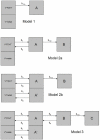Pharmacokinetic assessment of the uptake of 16beta-18F-fluoro-5alpha-dihydrotestosterone (FDHT) in prostate tumors as measured by PET
- PMID: 20080885
- PMCID: PMC2866076
- DOI: 10.2967/jnumed.109.066159
Pharmacokinetic assessment of the uptake of 16beta-18F-fluoro-5alpha-dihydrotestosterone (FDHT) in prostate tumors as measured by PET
Abstract
The aim of this study was to develop a clinically applicable noninvasive method to quantify changes in androgen receptor (AR) levels based on (18)F-16beta-fluoro-5alpha-dihydrotestosterone ((18)F-FDHT) PET in prostate cancer patients undergoing therapy.
Methods: Thirteen patients underwent dynamic (18)F-FDHT PET over a selected tumor. Concurrent venous blood samples were acquired for blood metabolite analysis. A second cohort of 25 patients injected with (18)F-FDHT underwent dynamic PET of the heart. These data were used to generate a population-based input function, essential for pharmacokinetic modeling. Linear compartmental pharmacokinetic models of increasing complexity were tested on the tumor tissue data. Four suitable models were applied and compared using the Bayesian information criterion (BIC). Model 1 consisted of an instantaneously equilibrating space, followed by a unidirectional trap. Models 2a and 2b contained a reversible space between the instantaneously equilibrating space and the trap, into which metabolites were excluded (2a) or allowed (2b). Model 3 built on model 2b with the addition of a second reversible space preceding the unidirectional trap and from which metabolites were excluded.
Results: The half-life of the (18)F-FDHT in blood was between 6 and 7 min. As a consequence, the uptake of (18)F-FDHT in prostate cancer lesions reached a plateau within 20 min as the blood-borne activity was consumed. Radiolabeled metabolites were shown not to bind to ARs in in vitro studies with CWR22 cells. Model 1 produced reasonable and robust fits for all datasets and was judged best by the BIC for 16 of 26 tumor scans. Models 2a, 2b, and 3 were judged best in 7, 2, and 1 cases, respectively.
Conclusion: Our study explores the clinical potential of using (18)F-FDHT PET to estimate free AR concentration. This process involved the estimation of a net uptake parameter such as the k(trap) of model 1 that could serve as a surrogate measure of AR expression in metastatic prostate cancer. Our initial studies suggest that a simple body mass-normalized standardized uptake value correlates reasonably well to model-based k(trap) estimates, which we surmise may be proportional to AR expression. Validation studies to test this hypothesis are underway.
Figures







Similar articles
-
In vivo imaging of brain androgen receptors in rats: a [(18)F]FDHT PET study.Nucl Med Biol. 2015 Jun;42(6):561-9. doi: 10.1016/j.nucmedbio.2015.02.003. Epub 2015 Feb 11. Nucl Med Biol. 2015. PMID: 25735222
-
Tumor localization of 16beta-18F-fluoro-5alpha-dihydrotestosterone versus 18F-FDG in patients with progressive, metastatic prostate cancer.J Nucl Med. 2004 Mar;45(3):366-73. J Nucl Med. 2004. PMID: 15001675 Clinical Trial.
-
Positron tomographic assessment of androgen receptors in prostatic carcinoma.Eur J Nucl Med Mol Imaging. 2005 Mar;32(3):344-50. doi: 10.1007/s00259-005-1764-5. Epub 2005 Feb 22. Eur J Nucl Med Mol Imaging. 2005. PMID: 15726353 Clinical Trial.
-
Current applications of PET imaging of sex hormone receptors with a fluorinated analogue of estradiol or of testosterone.Q J Nucl Med Mol Imaging. 2015 Mar;59(1):4-17. Epub 2015 Feb 19. Q J Nucl Med Mol Imaging. 2015. PMID: 25693420 Review.
-
[18F]-FDHT PET for the Imaging of Androgen Receptor in Prostate and Breast Cancer: A Systematic Review.Diagnostics (Basel). 2023 Aug 7;13(15):2613. doi: 10.3390/diagnostics13152613. Diagnostics (Basel). 2023. PMID: 37568977 Free PMC article. Review.
Cited by
-
Fully automated synthesis of [(18) F]fluoro-dihydrotestosterone ([(18) F]FDHT) using the FlexLab module.J Labelled Comp Radiopharm. 2016 Aug;59(10):424-8. doi: 10.1002/jlcr.3417. Epub 2016 Jul 4. J Labelled Comp Radiopharm. 2016. PMID: 27378195 Free PMC article.
-
Molecular imaging of prostate cancer: PET radiotracers.AJR Am J Roentgenol. 2012 Aug;199(2):278-91. doi: 10.2214/AJR.12.8816. AJR Am J Roentgenol. 2012. PMID: 22826388 Free PMC article. Review.
-
Impact of expression system on the function of the C6.5 diabody PET radiotracer.Tumour Biol. 2012 Jun;33(3):617-27. doi: 10.1007/s13277-012-0361-z. Epub 2012 Mar 1. Tumour Biol. 2012. PMID: 22383295 Free PMC article.
-
Fully-automated synthesis of 16β-(18)F-fluoro-5α-dihydrotestosterone (FDHT) on the ELIXYS radiosynthesizer.Appl Radiat Isot. 2015 Sep;103:9-14. doi: 10.1016/j.apradiso.2015.05.010. Epub 2015 May 21. Appl Radiat Isot. 2015. PMID: 26046518 Free PMC article.
-
PET imaging in prostate cancer: focus on prostate-specific membrane antigen.Curr Top Med Chem. 2013;13(8):951-62. doi: 10.2174/1568026611313080008. Curr Top Med Chem. 2013. PMID: 23590171 Free PMC article. Review.
References
-
- Choe YS, Lidström PJ, Chi DY, Bonasera TA, Welch MJ, Katzenellenbogen JA. Synthesis of 11 beta-[18F]fluoro-5 alpha-dihydrotestosterone and 11 beta-[18F]fluoro-19-nor-5 alpha-dihydrotestosterone: preparation via halofluorination-reduction, receptor binding, and tissue distribution. J Med Chem. 1995;38:816–825. - PubMed
-
- Bonasera TA, Oneil JP, Xu M, et al. Preclinical evaluation of fluorine-18-labeled androgen receptor ligands in baboons. J Nucl Med. 1996;37:1009–1015. - PubMed
-
- Dehdashti F, Picus J, Michalski JM, et al. Positron tomographic assessment of androgen receptors in prostatic carcinoma. Eur J Nucl Med Mol Imaging. 2005;32:344–350. - PubMed
-
- Larson SM, Morris M, Gunther I, et al. Tumor localization of 16beta-18F-fluoro-5alpha-dihydrotestosterone versus 18F-FDG in patients with progressive, metastatic prostate cancer. J Nucl Med. 2004;45:366–373. - PubMed
Publication types
MeSH terms
Substances
Grants and funding
LinkOut - more resources
Full Text Sources
Other Literature Sources
Medical
Research Materials
